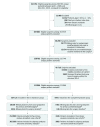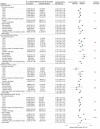Association Between Handover of Anesthesia Care and Adverse Postoperative Outcomes Among Patients Undergoing Major Surgery
- PMID: 29318277
- PMCID: PMC5833659
- DOI: 10.1001/jama.2017.20040
Association Between Handover of Anesthesia Care and Adverse Postoperative Outcomes Among Patients Undergoing Major Surgery
Abstract
Importance: Handing over the care of a patient from one anesthesiologist to another occurs during some surgeries and might increase the risk of adverse outcomes.
Objective: To assess whether complete handover of intraoperative anesthesia care is associated with higher likelihood of mortality or major complications compared with no handover of care.
Design, setting, and participants: A retrospective population-based cohort study (April 1, 2009-March 31, 2015 set in the Canadian province of Ontario) of adult patients aged 18 years and older undergoing major surgeries expected to last at least 2 hours and requiring a hospital stay of at least 1 night.
Exposure: Complete intraoperative handover of anesthesia care from one physician anesthesiologist to another compared with no handover of anesthesia care.
Main outcomes and measures: The primary outcome was a composite of all-cause death, hospital readmission, or major postoperative complications, all within 30 postoperative days. Secondary outcomes were the individual components of the primary outcome. Inverse probability of exposure weighting based on the propensity score was used to estimate adjusted exposure effects.
Results: Of the 313 066 patients in the cohort, 56% were women; the mean (SD) age was 60 (16) years; 49% of surgeries were performed in academic centers; 72% of surgeries were elective; and the median duration of surgery was 182 minutes (interquartile [IQR] range, 124-255). A total of 5941 (1.9%) patients underwent surgery with complete handover of anesthesia care. The percentage of patients undergoing surgery with a handover of anesthesiology care progressively increased each year of the study, reaching 2.9% in 2015. In the unweighted sample, the primary outcome occurred in 44% of the complete handover group compared with 29% of the no handover group. After adjustment, complete handovers were statistically significantly associated with an increased risk of the primary outcome (adjusted risk difference [aRD], 6.8% [95% CI, 4.5% to 9.1%]; P < .001), all-cause death (aRD, 1.2% [95% CI, 0.5% to 2%]; P = .002), and major complications (aRD, 5.8% [95% CI, 3.6% to 7.9%]; P < .001), but not with hospital readmission within 30 days of surgery (aRD, 1.2% [95% CI, -0.3% to 2.7%]; P = .11).
Conclusions and relevance: Among adults undergoing major surgery, complete handover of intraoperative anesthesia care compared with no handover was associated with a higher risk of adverse postoperative outcomes. These findings may support limiting complete anesthesia handovers.
Conflict of interest statement
Figures


Comment in
-
Handovers During Anesthesia Care: Patient Safety Risk or Opportunity for Improvement?JAMA. 2018 Jan 9;319(2):125-127. doi: 10.1001/jama.2017.20602. JAMA. 2018. PMID: 29318263 No abstract available.
-
Anesthesia Care Handovers and Risk of Adverse Outcomes.JAMA. 2018 Jun 5;319(21):2235. doi: 10.1001/jama.2018.4430. JAMA. 2018. PMID: 29872852 No abstract available.
-
Anesthesia Care Handovers and Risk of Adverse Outcomes.JAMA. 2018 Jun 5;319(21):2236. doi: 10.1001/jama.2018.4434. JAMA. 2018. PMID: 29872853 No abstract available.
-
Anesthesia Care Handovers and Risk of Adverse Outcomes.JAMA. 2018 Jun 5;319(21):2236-2237. doi: 10.1001/jama.2018.4438. JAMA. 2018. PMID: 29872854 No abstract available.
-
Anesthesia Care Handovers and Risk of Adverse Outcomes.JAMA. 2018 Jun 5;319(21):2235-2236. doi: 10.1001/jama.2018.4442. JAMA. 2018. PMID: 29872855 No abstract available.
-
Anesthesia Care Handovers and Risk of Adverse Outcomes.JAMA. 2018 Jun 5;319(21):2237. doi: 10.1001/jama.2018.4450. JAMA. 2018. PMID: 29872856 No abstract available.
References
-
- Irony TZ. The “utility” in composite outcome measures: measuring what is important to patients. JAMA. 2017;318(18):1820-1821. - PubMed
Publication types
MeSH terms
Grants and funding
LinkOut - more resources
Full Text Sources
Other Literature Sources
Medical
Miscellaneous

